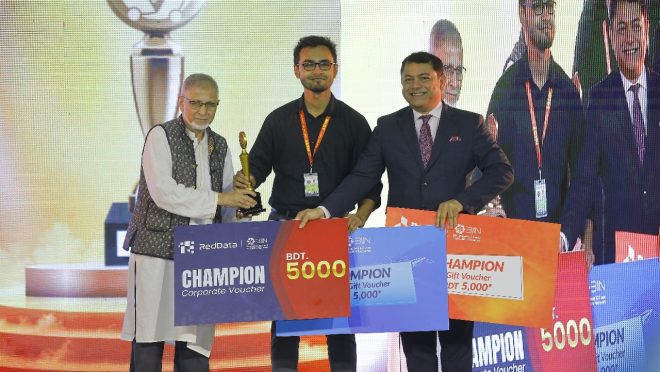RADSAFE and Bangladesh’s path to self-reliance
RADSAFE and Bangladesh’s path to self-reliance

While nuclear safety is seldom a concern for poorer developing nations such as Bangladesh, one undergraduate student of Nuclear Science and Engineering at the Military Institute of Science and Technology (MIST), Mubin Hossain Omio, and his project RADSAFE address this issue head-on.
After winning the Championship Gold Award at the Bangladesh ICT and Innovation Awards 2025, Mubin expressed his vision for Bangladesh’s nuclear safety through his project RADSAFE.
Journey towards effective radiation detection
“In our nuclear field, it is very hard to get hands-on experience or access to nuclear tech,” Mubin says. Devices such as radiation detectors and other instrumental technologies are priced between Tk1 and Tk2 crore, making them inaccessible for undergraduate or even postgraduate students and their universities.
“Buying a technology doesn’t make us own it until we can make it ourselves,” he adds. A statement that perfectly captures his motivation to design RADSAFE, a low-cost, high-functioning radiation monitoring system made entirely in Bangladesh.
Radiation detection is not just meant for exploring nuclear danger zones. Hospitals, research facilities, and future nuclear power plants all require adequate detection systems so that the safety and well-being of the doctors and engineers operating and living close to those facilities can be safe.
When these devices malfunction, repairs can take up to a year, leaving many medical centres with faulty detectors that simply gather dust. RADSAFE was built to end that dependency.
“Most of our country’s medicine and diagnostic centres have the same problem: faulty detectors,” Mubin explains. “They can’t fix them or buy new ones. That’s dangerous because it compromises radiation safety.” His project isn’t just a technical innovation; it’s a response to a national safety challenge.
The technology behind RADSAFE
As per the description, it is a “complete radiation detection and monitoring system combining IoT, AI, and machine learning.”
The device collects real-time data of temperature, humidity, air pressure, and air quality, all visualised through a web-based monitoring system, while machine learning algorithms analyse anomalies and trigger emergency alerts.
In the moments of radiation spillovers, its real-time data analysis feature has the ability to determine escape routes for people entrapped. This, Mubin notes, can be vital during nuclear accidents or medical radiation leaks, situations where every second counts.
From a technical standpoint, RADSAFE is built with Geiger–Müller tubes and multi-parameter sensors connected to a microcontroller that transmits data to the cloud. The system’s web interface integrates AI-based analytics, allowing radiation protection officers to make quick, data-driven decisions following IAEA (International Atomic Energy Agency) regulations.
Challenges
“It took me more than a year,” Omio recalls. “There were so many challenges from calibrating sensors to debugging software. I lost a lot of time and money due to faulty parts and errors. It was frustrating,” described Mubin.
He also expressed the critical role of his supervisor, Professor Dr. Abdus Sattar Mollah, former Director of the Nuclear Safety and Radiation Control Division at the Bangladesh Atomic Energy Commission. “The way he cherished and inspired me with my work was amazing,” Mubin says gratefully.
The road to winning the Gold Award at the Bangladesh ICT & Innovation Awards 2025 from a suggestion of his close junior. “I completely changed the hardware outlook to make it more presentable. It took a lot of time, but it was worth it,” he says. When his name was announced as the Champion Gold Award winner, it wasn’t just a victory for him but for homegrown innovation.
He believes the innovation will have a long-term societal impact as well. By introducing RADSAFE to educational institutions, Mubin hopes to dispel public fear of radiation, the “invisible enemy,” as he calls it, and build awareness of its uses and risks. “People often fear radiation because of accidents like Chernobyl or Fukushima,” he explains. “But radiation can save lives if used safely and wisely.”
Looking ahead, Mubin is already working to bring RADSAFE to the market through collaborations with companies and research organisations. His goal is to make it a nationally adopted standard for radiation monitoring, a system built in Bangladesh for Bangladesh.


